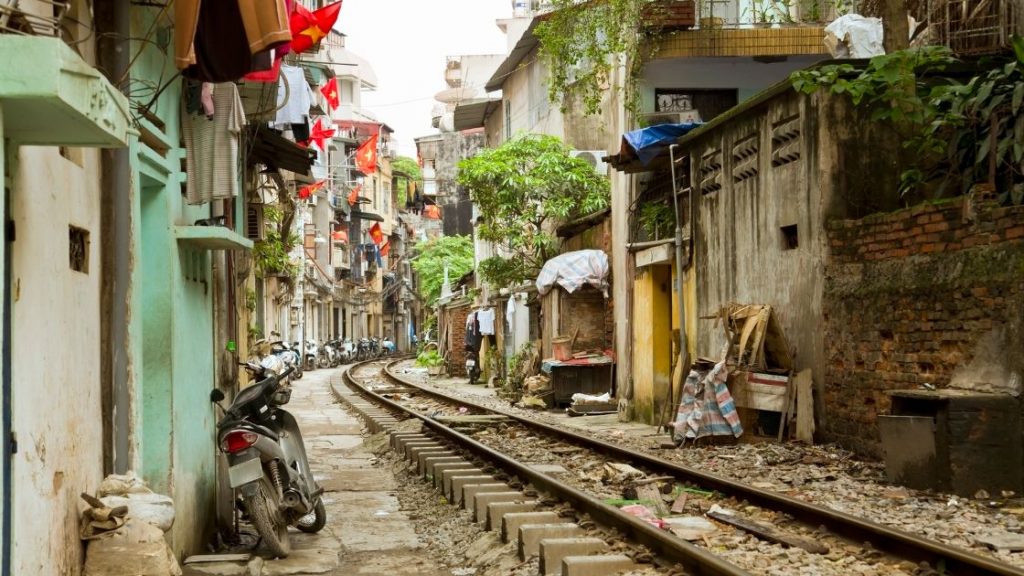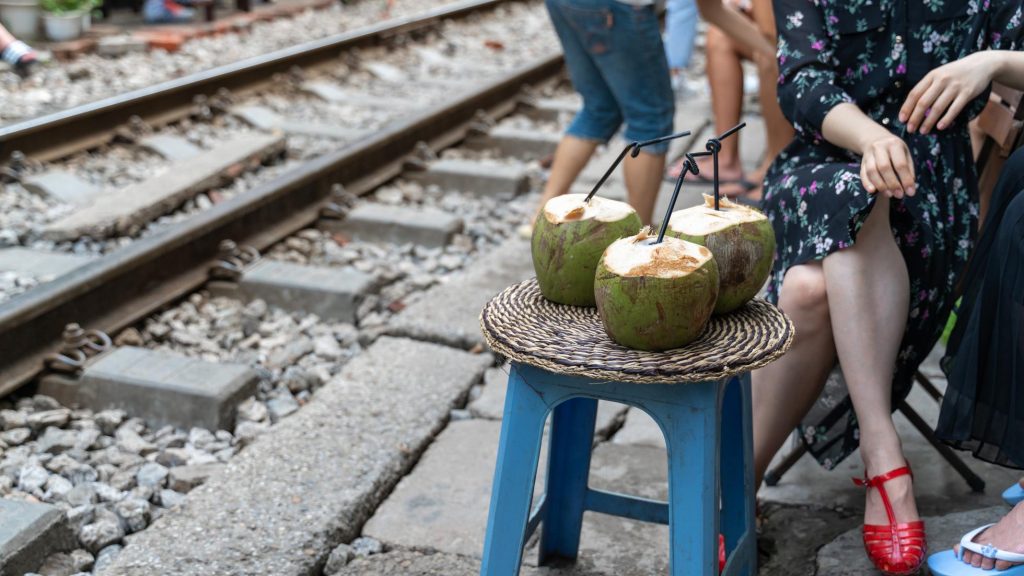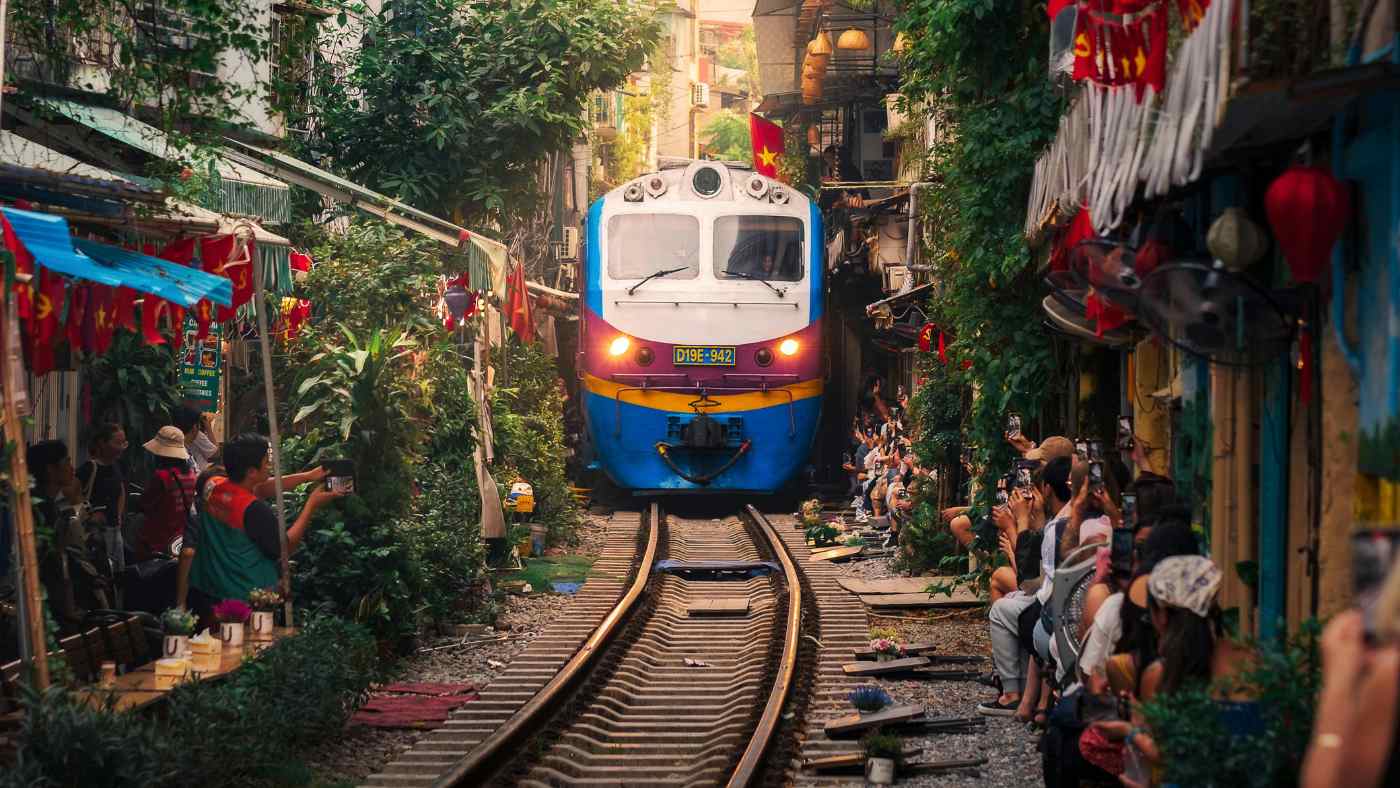Hanoi Train Street has rapidly become one of Vietnam’s most iconic and buzzworthy attractions. With its narrow, bustling lanes and houses built dangerously close to active train tracks, this unique location offers an unforgettable blend of thrill, culture, and everyday local life that you cannot find anywhere else.
Whether you’re a photography enthusiast, a culture vulture, or an adventurous traveller eager to experience something off the beaten path, train Street Hanoi is a must when visiting the city. This comprehensive guide will answer the most frequently asked questions about Ha Noi Train Street and provide all the insider tips you need to plan a safe and enjoyable visit.
Where is Hanoi Train Street?

Hanoi Train Street is a narrow section of road in the heart of Hanoi’s Old Quarter, where a functioning railway line runs directly alongside closely packed houses, cafés, and local businesses. Despite its precarious appearance, it is a vibrant community where locals have learned to coexist with the roaring trains that pass by several times a day.
Hanoi Train Street is located in the Old Quarter of Hanoi, specifically between Phùng Hưng and Lý Nam Đế streets. One of the train streets is Le Duan Street, which is at the entrance of the Ha Noi train station.
There is another train in Phung Hung and Tran Phu Street in Ha Noi. Phung Hung Train Street is close to Phung Hung Mural Street, but to reach there, one has to go inside the narrow lanes of the Old Quarter.
What makes Hanoi Train Street so unique is the sheer closeness of the train to residential areas (with the safety line marked by yellow paint a mere 20 centimetres from the houses) and the spirit of the local community. Locals quickly retreat indoors as the train approaches and then emerge almost immediately after it passes, as if nothing unusual had occurred. This blend of calm resilience and vibrant energy has made Hanoi Train Street a must-see destination for anyone visiting Vietnam. The train street is lined with several cafes where you can sit and wait for the train.
You can find it on Google Maps by simply searching for “Hanoi Train Street.” The area is well-known to locals, and you can also ask for directions from taxi or motorbike taxi drivers, known locally as “xe ôm.” Because this is still a residential neighbourhood, it is essential to respect the local community—remember that many families live here, and their privacy should be honoured.
What time does the train come on Hanoi Train Street?
One of the most common questions visitors ask is, “What time does the train come to Hanoi Train Street?” While an official timetable is posted at some of the local cafés, the train schedule can be somewhat unpredictable. On weekdays, the train typically passes in the early evening, while on weekends, it runs several times throughout the day.
For example, one widely referenced schedule is as follows:
- Monday – Friday (Evenings):
7:00 PM, 7:45 PM, 8:45 PM, 9:30 PM, and 10:00 PM. - Saturday and Sunday (All Day):
8:30 AM, 9:30 AM, 11:30 AM, 3:20 PM, 4:30 PM, 5:30 PM, 6:00 PM, 7:20 PM, 7:45 PM, 8:45 PM, and 9:15 PM.
However, many travellers have noted that these times are only guidelines. In some cases, additional train passes occur unexpectedly, or the train may be delayed.
Insider Tips for Visiting Hanoi Train Street
Visiting Hanoi Train Street can be an exhilarating experience, but it’s important to plan ahead and follow some essential guidelines to ensure your safety and enjoyment.
1. Arrive Early for a Good Spot
Given the popularity of Hanoi Train Street, especially during the scheduled train passes, arriving at least 30 minutes early is crucial. This secures you a prime viewing spot and gives you time to settle in at a café or along the designated walking path.
2. Follow Safety Guidelines
The area is undoubtedly thrilling, but safety should always come first. When the train is approaching, follow the instructions of local café owners or designated guides. Do not attempt to stand too close to the tracks—stick to the marked safe zones. Remember, the yellow safety line is there for a reason.
3. Stay Ahead of the Schedule with the help of Locals
You should ask one of the local café owners once you arrive for the most reliable information. They usually display the current Hanoi train street schedule and can tell you if any changes or extra trains are coming that aren’t on the official list.
Because the train times can change, always arrive at least 30 minutes before your desired viewing time to secure a good spot. This buffer period will allow you to settle in at one of the many cafés that line the street, serving as viewing platforms and refreshment stops.
If you’re planning a visit, aim to be flexible with your timing and consider spending a bit more time in the area to catch all possible passes.
4. Use Reliable Transportation
Getting to Train Street is straightforward, with taxis and motorbike taxis (xe ôm) readily available in the Old Quarter. If you prefer public transportation, several buses stop near Le Duan, Tran Phu, or Phùng Hưng streets. Local e-hailing services like Grab can also provide a convenient and safe way to reach your destination.
5. Check the Train Schedule Frequently
Since the Hanoi train street schedule can change, it’s a good idea to double-check the timings upon arrival. Many cafés display updated timetables, and a quick conversation with a local vendor can provide you with the latest information. This ensures that you won’t miss any unexpected train passes that could be the highlight of your visit.
6. Enjoy the Local Cafés

One of the best ways to experience Train Street is by visiting one of the many train-themed cafés that have sprung up along the street. These cafés offer a safe viewing spot and serve delicious Vietnamese coffee and traditional snacks. Popular spots include Café 90 Đường Tàu, Cafe Sân Ga, and 65 Railway Coffee. Each café offers a unique ambience, perfect for capturing memorable photos and soaking in the vibrant atmosphere.
7. Plan Your Visit According to the Weather
The experience of Train Street can vary greatly depending on the weather. If you prefer natural light for photography, consider visiting on a clear weekend morning. However, an evening visit on a weekday might be ideal to witness the dramatic play of lights and shadows as the train passes at dusk. Always check the local weather forecast to plan accordingly.
8. Photography Tips for Hanoi Train Street

For photography enthusiasts, Hanoi Train Street offers a rare opportunity to capture the intersection of daily life and a moving train mere inches away from residential homes. Here are a few tips to help you get the perfect shot:
- Use a Tripod: The low-light conditions during evening passes make a tripod essential for sharp, well-exposed photos.
- Respect Privacy: Always ask permission before taking close-up shots of locals or their homes.
- Experiment with Angles: Try capturing both wide-angle shots to showcase the street and close-up details of the train and the unique architecture.
- Safety First: Ensure you remain in the designated safe zones while taking photos.
9. Be Respectful of the Locals
Hanoi Train Street is a residential area where people live their daily lives. Always respect the locals by not trespassing on private property and asking for permission before taking photographs of residents or their homes.
Hanoi Train Street is more than just an Instagram hotspot—it is a living, breathing part of Hanoi’s urban landscape. The excitement of watching a train roar past a narrow street lined with traditional houses and quirky cafés encapsulates the dynamic and resilient spirit of the city. Although the schedule might sometimes be unpredictable, the thrill of the moment and the rich cultural context make it a must-visit destination in Hanoi.
In conclusion, whether you’re visiting on a weekday evening or a bustling weekend morning, enjoy your adventure in one of Hanoi’s most mesmerizing attractions, and remember—the best time to experience it is always now!
Are you planning to extend your Vietnam trip? Just a scenic journey from Hanoi, Sa Pa is a haven for travellers interested in lush rice terraces, majestic mountain views, and vibrant ethnic minority cultures.
Sa Pa is easily accessible from Hanoi by a combination of train and bus services or even a direct overnight train, making it a convenient extension of your northern Vietnam adventure. You can also catch a bus from Ha Noi to Sa Pa from top bus and limousine service providers in Vietnam. Once in Sa Pa, you can explore terraced fields, visit local markets, and experience the warmth of the Hmong and Dao communities. Whether you’re trekking in Sa Pa through misty valleys or simply relaxing in a cozy mountain lodge, Sa Pa perfectly contrasts the urban intensity of Hanoi.
